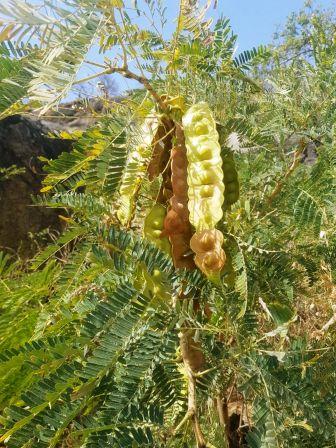Entada africana

|
|
Entada africana Common Names: African Dream Herb, Snuffbox Sea Bean,
Calling Card Vine Scientific
Classification Kingdom: Plantae Phylum: Angiosperms Class: Eudicots Order: Fabales Family: Fabaceae Genus: Entada Species: E. africana Binomial Name: Entada africana Guill. & Perr. Synonyms: Entada sudanensis Schweinf., Entada wahlbergii Harv., Piptadenia africana (Guill. & Perr.) Brenan Morphological Description Entada africana is a woody, climbing shrub or small tree, reaching 3–15 m in
height or length. Key features include: · Stems: Thorny, woody, twining, up to 20 cm in diameter · Leaves: Bipinnate, 10–30 cm long, with 8–20 pairs of leaflets, each
2–5 cm long · Flowers: Small, creamy-white to yellowish, in spikes 5–15 cm long · Pods: Large, flat, woody, 30–120 cm long, 8–15 cm wide, containing
5–15 seeds · Seeds: Disc-shaped, 3–5 cm in diameter, shiny brown, hard-coated Its massive pods and
buoyant seeds aid dispersal by water (Yusuf & Abdullahi, 2019). Distribution and Habitat Entada africana thrives in: · Native Range: Tropical Africa (Senegal to Sudan, south to South Africa) · Habitat: Savannas, riverine forests, coastal scrubs, woodlands;
0–1,500 m altitude · Climate: Warm, humid, 25–35°C, rainfall 800–2,000 mm · Soil: Sandy to loamy, well-drained, pH 5.5–7 It is widespread across
sub-Saharan Africa, often near watercourses (PROTA, 2019). Ethnopharmacology Entada africana, commonly known as the African climbing tree or twining entada,
is a medicinal plant native to tropical Africa and widely used in traditional
African medicine. Various parts of the plant ,especially the leaves, bark,
roots, and seeds are rich in bioactive compounds such as flavonoids, tannins,
saponins, alkaloids, and terpenoids, which contribute to its wide-ranging
medicinal properties.Traditionally, Entada africana is used to treat
inflammatory conditions, fever, malaria, wounds, rheumatism, cough, bronchitis,
diarrhea, and skin infections. Scientific studies support its
anti-inflammatory, antimicrobial, antioxidant, analgesic, and antipyretic
activities. The plant also exhibits hepatoprotective and nephroprotective
effects, which may help protect the liver and kidneys from damage. Its
antimalarial potential has been noted in some studies, and it is sometimes used
as a natural painkiller in traditional medicine. While Entada africana shows
great promise as a therapeutic plant, further toxicological and clinical
studies are needed to validate its safety and efficacy for use in modern
medicine. · Intestinal Issues: Seed decoction in Nigeria is used for
antidiarrheal. · Wounds/Skin Ailments: Bark paste in Ghana; antibacterial
against S. aureus (MIC
0.5 mg/mL) (Yusuf & Abdullahi, 2019). · Fever: Bark infusion in Mali; antipyretic in mice (35% at 200
mg/kg) (Ezenyi et al., 2014). · Muscle Pain: Leaf extract in Benin; analgesic in mice (40% at 300 mg/kg)
(Codo Toafode et al., 2022). · Anti-inflammatory: Stem bark in Cameroon; suppresses LPS-induced
inflammation (IC₅₀ 12 µg/mL) (Ayissi et al., 2013). · Hepatoprotection: Root extract in Cameroon; reduces
CCl₄-induced liver damage (50% at 200 mg/kg) (Kouam et al., 2020).
⚠ Toxicity Profile: Safe at <500 mg/kg (LD₅₀ > 2,000 mg/kg in
rats); high doses may cause gastrointestinal distress or liver stress (Hassan
et al., 2017). Additional Information · Seed Use: Seeds crafted into jewelry (beads, necklaces) and snuffboxes
due to size and durability (PROTA, 2019). · Environmental Role: Supports forest regeneration, provides
shade, and hosts epiphytes (Yusuf & Abdullahi, 2019). · Cultural Use: Seeds used in rituals as “dream herbs” in South Africa
(Fern, 2023). · Other Uses: Bark for fiber, leaves as fodder (5–10% grazed) (PROTA,
2019). References
External Links More Pictures
|
|
| Compounds of Entada africana | |
| References |